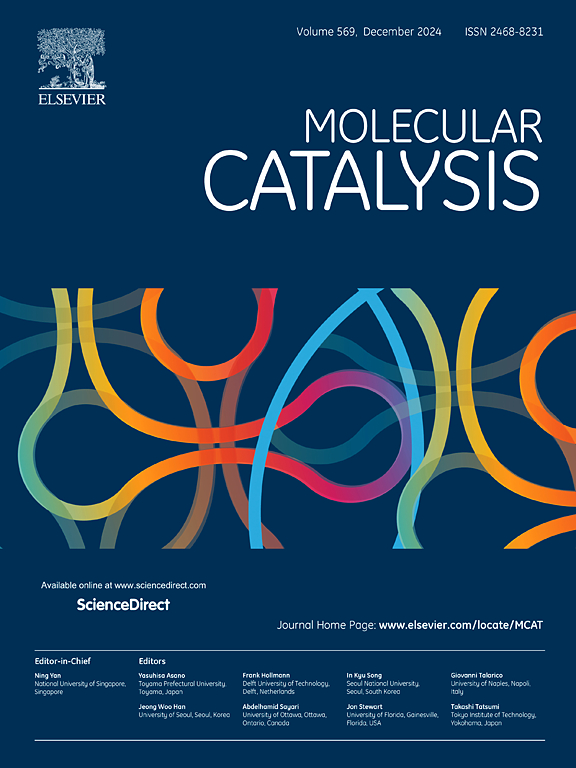铁-腐蚀锌基单原子电催化no - nh3转化的理论研究
IF 4.9
2区 化学
Q2 CHEMISTRY, PHYSICAL
引用次数: 0
摘要
电化学将NO转化为增值NH3是解决能源挑战和减轻环境污染的一种很有前途的策略。虽然贵金属基催化剂目前在电催化NO还原反应(eNORR)研究中占主导地位,但其实际应用仍然受到成本过高和原子利用效率有限的制约。非贵金属腐蚀剂在均相体系中表现出显著的催化能力,为实现eNORR提供了创新的可能性。在此,我们设计了一个二维fe - corlazine单原子催化剂(2D-Fecor SAC),通过铁- corlazine单元的炔基桥组装。然后进行了密度泛函理论(DFT)的广泛计算,以探索其结构和电子性质,以及其eNORR催化行为。结果表明,2D-Fecor SAC具有优异的稳定性,每个Fe原子保持其催化活性中心,可以有效吸附和活化NO。值得注意的是,2D-Fecor SAC通过n -远端通路表现出优越的eNORR性能,达到- 0.44 V的低极限电位,显著抑制了析氢反应(HER)。关键是,水环境提高了催化效率,并进一步将极限电位降至- 0.18 V。这种重要的活性源于协同效应:腐蚀碱框架实现了精确的电子转移调制,而铁中心促进了有效的电荷传输。我们的工作为开发具有成本效益的电催化剂建立了一种新的方法,同时修复NO污染和产生可持续的氨。本文章由计算机程序翻译,如有差异,请以英文原文为准。

Theoretical investigation of Fe-corrolazine-based single-atom electrocatalysis for NO-to-NH3 conversion
The electrochemical conversion of NO into value-added NH3 presents a promising strategy for addressing energy challenges and mitigating environmental pollution. Although noble metal-based catalysts currently predominate in electrocatalytic NO reduction reaction (eNORR) research, their practical deployment remains constrained by excessive costs and limited atomic utilization efficiency. Non-noble metal corrolazines have shown remarkable catalytic capabilities in homogeneous systems, presenting innovative possibilities for eNORR implementation. Herein, we engineered a two-dimensional Fe-corrolazine single-atom catalyst (2D-Fecor SAC) through alkynyl-bridged assembly of Fe-corrolazine units. Then extensive density functional theory (DFT) calculations were conducted to explore its structural and electronic properties, as well as its eNORR catalytic behavior. The results show 2D-Fecor SAC exhibits excellent stability, and each Fe atom retains its catalytic active center, which can effectively adsorb and activate NO. Notably, 2D-Fecor SAC exhibits superior eNORR performance via an N-distal pathway, achieving a low limiting potential of −0.44 V with significant suppression of the hydrogen evolution reaction (HER). Crucially, aqueous environments enhance the catalytic efficiency and further reduce the limiting potential to −0.18 V. This significant activity originates from synergistic effects: the corrolazine framework enables precise electron transfer modulation while Fe centers facilitate efficient charge transport. Our work establishes a novel approach for developing cost-effective electrocatalysts to simultaneously remediate NO pollution and produce sustainable ammonia.
求助全文
通过发布文献求助,成功后即可免费获取论文全文。
去求助
来源期刊

Molecular Catalysis
Chemical Engineering-Process Chemistry and Technology
CiteScore
6.90
自引率
10.90%
发文量
700
审稿时长
40 days
期刊介绍:
Molecular Catalysis publishes full papers that are original, rigorous, and scholarly contributions examining the molecular and atomic aspects of catalytic activation and reaction mechanisms. The fields covered are:
Heterogeneous catalysis including immobilized molecular catalysts
Homogeneous catalysis including organocatalysis, organometallic catalysis and biocatalysis
Photo- and electrochemistry
Theoretical aspects of catalysis analyzed by computational methods
 求助内容:
求助内容: 应助结果提醒方式:
应助结果提醒方式:


